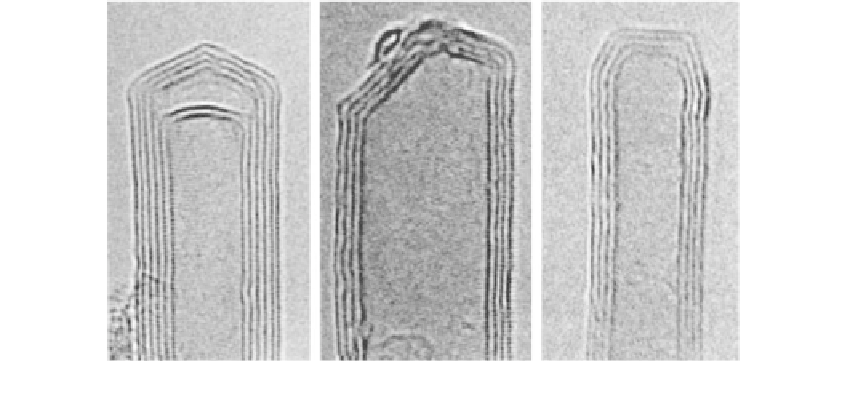Biomedical Engineering Reference
In-Depth Information
to a lower free energy for S-SWCNTs, according to a theoretical calculation [35]. This rep-
resents great progress toward future control of synthesis resulting in predictable structures
on a large scale.
12.2.3.2 Multi-Walled Carbon Nanotubes
The growth mechanisms of MWCNTs remain controversial despite all efforts, both exper-
imental and theoretical. The debate is mainly over whether CNTs exhibit a Russian-doll or
scrolled structure [36,37]. Many TEM observations of MWCNTs have shown coaxial struc-
tures according to Russian-doll model, which generally consist of multilayered, concentric
cylinders of individual graphene sheets (Figure 12.6). Such nanotubes are generally pro-
duced either by the electric-arc technique (without the need of any catalyst) or by catalyst-
enhanced thermal cracking of hydrocarbon feeds.
Although many people have accepted the Russian-doll model (comprising nested con-
centric tubes), recent results have also shown the presence of a scroll structure in many
tubes. Amelinckx et al. [39] observed a disrupted layer by HRTEM and proposed a mixed
model involving both concentric cylinders and a scroll-type structure. Xu and coworkers
[40] used high-resolution x-ray diffraction to provide further support for the scroll model.
More recently, Sun et al. [41] used HRTEM to observe MWCNTs grown by ohmically heat-
ing the catalytic sites; this provided direct evidence for the scroll model. They found that
the catalytic particle at the tip exhibits a cork-like shape conforming to the walls of the tube,
which also gradually becomes narrower (Figure 12.7A). Such a narrowing of the wall
simply corresponds to a decrease in the number of graphitic layers at the lattice fringes as
indicated by the arrows (Figure 12.7B). A close observation of the tube structure shows that
both the external and internal lattice fringes of the tube wall terminate at more or less reg-
ular intervals (Figure 12.7C), suggesting that these MWCNTs have a scrolled structure, as
depicted in Figure 12.7E. In this case, the entire nanotube is generated by a single graphene
sheet that produces new spirals inside the previous ones. In the scroll model, the Co-Ni
particles are continuously lifted up to maintain their initial shape and to create the spiral-
ing structure with a constant diameter. Further, they obtained additional evidence for the
growth of MWCNTs according to the scroll model by the deposition of platinum (Pt) NPs
(a)
(b)
(c)
FIGURE 12.6
High-resolution transmission electron microscopy images of concentric MWCNTs with closed caps. (From
Iijima, S. (1994). Carbon Nanotubes.
MRS Bull
.
,
19, 43-51.)


